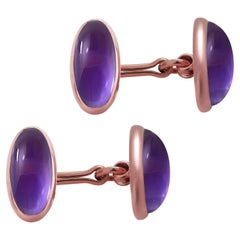Carter Howe
Recent Sales
Antique Late 19th Century American Art Nouveau Cufflinks
Amethyst, Rose Gold, Gold, 14k Gold
A Close Look at art-nouveau Jewelry
Art Nouveau — generally considered to have begun in the late 1800s and ended with the start of World War I — was a movement in the decorative arts that drew inspiration from natural forms, such as trees, flowers and, of course, the human figure. The three main themes present in Art Nouveau jewelry and watches were flora, fauna and women.
Art Nouveau, which reached its pinnacle in the year 1900, spawned from artists who rejected the historicism of their predecessors to create an entirely new visual vocabulary. As compared to Art Deco jewelry’s geometric patterns and sharp lines, the extravagant style of antique Art Nouveau jewelry is characterized by curvilinear forms and whiplash lines, vibrant materials and dramatic imagery.
The first art and design movement of the 20th century, Art Nouveau was also a reaction against the Industrial Revolution, and took its inspiration from the theories of the Symbolists, the art of the Pre-Raphaelites, the ideas of John Ruskin and his follower William Morris and, most importantly Japanese crafts. (The country was a fertile ground for inspiration after it was opened to the West in 1854.) The Art Nouveau style touched all manners of the arts, including the most exultant jewelry.
Nature was a favorite muse for artists going back to the 18th and 19th centuries, but in the hands of 20th-century artists, it was depicted in new ways. For example, a withering flower was considered just as beautiful as one in full bloom. Winged creatures, such as insects and birds, were also a popular subject. Dragonflies and butterflies were particular favorites because they morphed so dramatically in different life stages.
This was also a reference to women, whose role in society was evolving. It was not uncommon to see a piece of jewelry that would at once reference a woman as a winged creature (think René Lalique’s famous Dragonfly brooch, circa 1897–98, at the Gulbenkian Collection in Lisbon). However, just as women’s roles were ambiguous, so was their image, as the femmes nouvelle were simultaneously eroticized and romanticized.
In addition to Lalique, vital figures in Art Nouveau jewelry included Louis Comfort Tiffany in the United States, Vladimir Soloviev, who designed jewelry for Peter Carl Fabergé in Russia, Fuset Grau of Spain, Karl Rothmuller of Germany and Philippe Wolfers of Belgium.
Art Nouveau jewelers used every “canvas” imaginable, looking beyond brooches and necklaces to belt buckles, fans, tiaras, dog collars (a type of choker necklace), pocket watches, corsages and hair combs. Multicolored gems and enamel could complete this vision better than diamonds. Jewelers also favored pearls, particularly baroque pearls, for their large size and irregular shape. However, opal was the most popular stone — its iridescence harmonized perfectly with the enamel, and it could be carved into any shape. Art Nouveau jewelry was primarily set in yellow gold.
Find a range of antique Art Nouveau jewelry today on 1stDibs.
Finding the Right cufflinks for You
Cufflinks rose to popularity during the 1800s as fashionable men sought a refined and elegant solution for keeping their shirtsleeves together. Prior to this accessory, which initially materialized as a simple chain fastened to a button, men were lacing the ends of their sleeves with ribbon or string. Today, there are all manner of antique and vintage cufflinks that add flair and functionality to relaxed casual wear as much as they do for classy formal attire.
It wasn’t long before diamonds, emeralds and other precious gemstones began to appear on cufflinks, a means of adding ornament to clean and starched formal wear. When clothing manufacturers began to produce shirt cuffs and collars with more durable materials during the 19th century, a class of newer, stronger cufflinks gained credibility as being both essential and stylish. In the decades following this era’s design evolution, an entire industry bloomed around the craft of these subtle statement pieces.
Luxury brands more often associated with engagement rings and bracelets, such as Cartier and Tiffany & Co., have added cufflinks to their lines over the years, and jewelry designers, working in numerous styles, have explored the use of different materials and integrated a variety of ornamentation. Understated cufflinks of gold and platinum are guaranteed to cleanly complement any ensemble, while more niche designs allow the jewels to truly shine.
Cufflinks are practical pieces of jewelry that can also be very expressive. Consider the event for which you’re donning cufflinks and accessorize accordingly, but know that a distinctive pair of cufflinks, such as the colorful confections offered by Trianon, can pop against your dressy evening wear. Whether they’re geometric wonders of the Art Deco era, reliably relevant skull jewels or glittering accessories designed by Van Cleef & Arpels, adorned with the maison’s celebrated four-leaf clover or prominent animal motifs, you can delicately break from what can be a stuffy business meeting by introducing personality and pizzazz with a duo of nifty cufflinks.
A carefully chosen set of cufflinks can bring a stylish outfit together — literally. Find a large, luxurious collection of contemporary cufflinks as well as irresistible vintage pieces on 1stDibs today.
